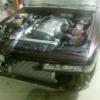Announcements
-
Similar Content
-
Latest Posts
-
Do you know where the EPS module will be located? And also the diagnostic connect located under the dash?
-
Well, yeah, there is a (very thin) layer of soft lead on the surface of bearing shells to provide that first "cushion" against physical contact. Just because it is wearing off doesn't actually mean that the engine is dying. Of course, it can mean that the engine is dying. If the engine is making no noises and the oil pressure is (mostly, as in most of the time) fine, then it could just be suffering under particular conditions. That could be startup, or maybe at some point in the normal operation cycle - or maybe the Beemer engine suffers under long left hand bend (see, highway on ramp) and the pressure drops. You'd need to try to work out if any such thing is happening and then determine if you need a bigger oil pump, or an Accusump or something.
-
I'm reading that lead is likely from bearings. Can these be caught before it's too late or is it doomed already?
-
I forgot to mention also that he cut the filter open and saw no glitter at all in there. Yep, I'l give him a call shortly. Fingers crossed!
-
It's not ideal, by any means, but I think many of the horror stories are because of people not understanding what it is, what it does, what their VSS that they need to modify looks like and whether the Jaycar unit is applicable. In principle, it is relatively easy to build a device to take in an AC variable (peak) voltage variable frequency signal (which is what you get from most Nissan speed senders) and just spit out a constant (peak) voltage variable frequency AC signal at a different (modified) frequency.
-





Recommended Posts
Create an account or sign in to comment
You need to be a member in order to leave a comment
Create an account
Sign up for a new account in our community. It's easy!
Register a new accountSign in
Already have an account? Sign in here.
Sign In Now